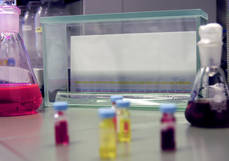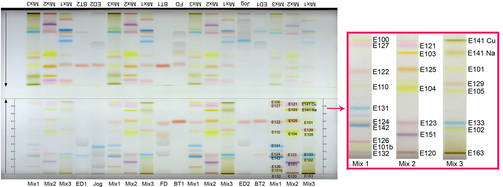Forschungsschwerpunkt
| Forschungsschwerpunkt: Planar-Chromatographie |
Planar chromatography comprises all chromatographic techniques, which have an open planar stationary phase present as or on a plane. Therein, the simple thin-layer chromatography (TLC) is the widest spread chromatographic technique; whereas high-performance TLC (HPTLC) is considered as the most efficient and powerful planar chromatographic technique standing for optimized coating material (lower particle size and narrower particle size distribution) in combination with the employment of advanced instrumentation for mostly all steps of the chromatographic process. HPTLC was turned out to be of high relevance in the age of ultra rapid separations because the planar format offers unrivalled features [36, 40, poster 57, poster 50]. 1000 matrix-robust sample runs per 8h-day are readily reached by HPTLC. This was shown for quantitative analysis of sucalose in milk confect and dietary food [19, 33, 35, poster 51] or for water-soluble food dyes in various food [47, 54 (in Chinese)].
|
|
Method development and sample throughput is very fast using HPTLC. This was shown for isopropylthioxanthone, a new contaminant found in milk, for which the newly developed HPTLC method was published first [20, 21]. Also difficult analyses can be performed by HPTLC like shown for heterocyclic aromatic amines [28, 39, poster 53] or acrylamide in drinking water [34, 37, poster 42 ], potatoe chips [poster 43] and coffee [50] leading to comparable results as obtained by HPLC. Further rapid screening is shown for PAH analysis in water samples [poster 52], additives in mineral oils with hyphenation of HPTLC with ATR-FTIR [poster 56, 42] or explosives [poster 68].
Hyphenation HPTLC-MS
During my Postdoctoral Lecture Qualification I successfully focussed on hyphenations [poster 70] and particularly on coupling of HPTLC with mass spectrometry (HPTLC-MS) because there has not been available any reasonable and practical coupling technique at the beginning. A key feature of HPTLC-MS is the cost-effective, targeted recording of mass spectra. Different approaches via open ionization sources, working under ambient pressure, were investigated [poster 49]. Direct analysis in real time (DART) was first coupled to planar chromatography by our group [20, 21, 25, 27, 31] as well as atmospheric pressure glow discharge (APGD) [25, 57]. Meanwhile optimized solutions like DART-ET are in progress. A company worked on a dedicated TLC-MALDI software and we adapted the protocol for matrix-assisted laser desorption & ionization (MALDI). Using this technqiue, HPTLC-MALDI-TOFMS achieved repeatabilites of about 10 % directly from the plate via Imaging MS [posters 64, 70, 72, 73]. We successfully modificated an interface, originally invented by Dr. Luftmann from University of Münster working on TLC flexible carriers, for its usage on TLC/HPTLC glass plates [23, 43]. We showed that, using this modified interface, detectabilities were comparable to HPLC-MS [22] and reliable quantification was possible as well [27, 30, 32, 57]. This modified interface was pointed out to be the most reliable and universal plug & play tool for HPTLC-MS coupling worldwide. Based on our research (over 15 original research papers) a company took over this successful approach and started marketing of the interface in spring 2009 (Flyer TLC-MS Interface). To conclude several practical options are now available for recording of mass spectra of zones of interest from the HPTLC plates within seconds [57].
Hyphenation HPTLC-EDA (effect-directed analysis)
HPTLC coupled with bioactivity-based detection by Vibrio fischeri bacteria was combined with high resolution mass spectrometry (HRMS). On the example of screening for bioactive natural products in marine sponges this effective analytical approach was demonstrated via HPTLC-UV/Vis/FLD-bioactivity-HRMS [45 (in Chinese), 46, poster 70]. All the following information was reached by a single HPTLC separation: (1) up to 30 sponges (just lyophilized, dissolved and centrifuged) were screened matrix-robust at one go for natural bioactive secondary products (UV/Vis/FLD/EDA images), (2) high producers of bioactive products were identified, (3) in-formation about the range of bioactive products produced by the sponge was given and (4) the sum formula was obtained from bioactive zones of interest.
Office Chromatography
Recently, our group has founded the new discipline combining planar chromatography with office peripherals, we called Office Chromatography [56, poster 59, presentation 116]. Focussing the open planar concept and participating in the worldwide progress of print & media technology, office chromatography will provide an ideal platform for miniaturized planar chromatography on ultrathin, nano-structured plates. Chromatographic runs are performed within a minute for many samples in parallel, meaning runs/sample below a second in a user-friendly environment. This new discipline is at its infancy, however, the fundamental proof was given in [56].
New impulses with great potential were given to the field of anaylsis. Konfuzius wisely said „Reaching the water source, you have to swim against mainstream“. That is particularly true for planar chromatography.


